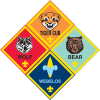
Into the Wild
Do you wonder about the sounds you hear at night? The howling, the hooting, and the whistling, humming sounds you hear? During the day, do you wonder where flocks of birds are going overhead? Why rabbits look like statues in the grass? When you go “Into the Wild” you will learn to understand the world of animals, birds, reptiles, amphibians, and insects that live with us day and night while they contribute to the world in which we live.
Rationale for Adventure
Learn about our ecosystem and appreciate nature.
Requirements
Webelos/AOL Elective Adventure: Into the Wild
Do six from requirements 1 through 9.
- Collect and care for an “insect, amphibian, or reptile zoo.” You might have crickets, ants, grasshoppers, a lizard, or a toad. Study them for a while and then let them go. Share your experience with your Webelos den.
- Set up an aquarium or terrarium. Keep it for at least a month. Share your experience with your Webelos den by showing them photos or drawings of your project or by having them visit to see your project.
- Watch for birds in your yard, neighborhood, or town for one week. Identify the birds you see, and write down where and when you saw them.
- Learn about the bird flyways closest to your home. Find out which birds use these flyways.
- Watch at least four wild creatures (reptiles, amphibians, arachnids, fish, insects, or mammals) in the wild. Describe the kind of place (forest, field, marsh, yard, or park) where you saw them. Tell what they were doing.
- Identify an insect, reptile, bird, or wild animal that is found only in your area of the country. Tell why it survives in your area.
- Give examples of at least two of the following:
- A producer, a consumer, and a decomposer in the food chain of an ecosystem
- One way humans have changed the balance of nature
- How you can help protect the balance of nature
- Learn about aquatic ecosystems and wetlands in your area. Talk with your Webelos den leader or family about the important role aquatic ecosystems and wetlands play in supporting life cycles of wildlife and humans, and list three ways you can help.
- Do ONE of the following:
- Visit a museum of natural history, a nature center, or a zoo with your family, Webelos den, or pack. Tell what you saw.
- Create a video of a wild creature doing something interesting, and share it with your family and den.






